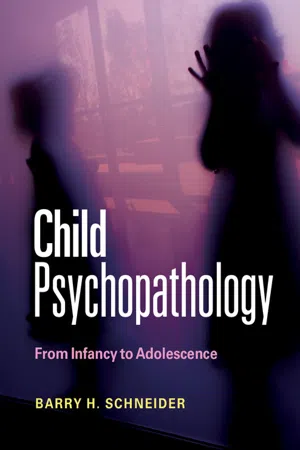
- English
- PDF
- Available on iOS & Android
About this book
This textbook covers the classification, causes, treatment and prevention of psychological disorders in the infant through the adolescent years. Chapters balance the social and historical context of psychopathology with the physiological roots of abnormal behavior, leading students to a comprehensive understanding of child psychopathology. The book is totally up-to-date, including coverage of the DSM-5 and criticisms of it. In four parts, this textbook describes the empirical bases of child psychopathology as well as the practice of child psychologists, outlining the classification and causes of disorders in addition to methods of assessment, intervention and treatment. Students will be able to evaluate the treatments used by professionals and debunk popular myths about atypical behavior and its treatment. Complementing the lively writing style, text boxes, clinical case studies and numerous examples from international cultures and countries add context to chapter material. Study questions, diagrams and a glossary offer further learning support.
Frequently asked questions
- Essential is ideal for learners and professionals who enjoy exploring a wide range of subjects. Access the Essential Library with 800,000+ trusted titles and best-sellers across business, personal growth, and the humanities. Includes unlimited reading time and Standard Read Aloud voice.
- Complete: Perfect for advanced learners and researchers needing full, unrestricted access. Unlock 1.4M+ books across hundreds of subjects, including academic and specialized titles. The Complete Plan also includes advanced features like Premium Read Aloud and Research Assistant.
Please note we cannot support devices running on iOS 13 and Android 7 or earlier. Learn more about using the app.
Information

Table of contents
- Cover
- Half title
- Title
- Copyright
- Dedication
- Contents
- Figures
- Tables
- Boxes
- Preface
- Part I Basic concepts and processes
- 1 Normality and abnormality in the context of human development: basic definitions
- 2 History: from ancient wisdom to the behavioral and cognitive revolutions
- 3 Classification of children’s psychological problems: pseudoscience or fundamental part of the helping process?
- 4 Genetics and psychopathology
- 5 The physiological underpinnings of child psychopathology
- 6 Family influences, family consequences and family interventions
- 7 The helpful and harmful influences of peers, friends and siblings
- 8 Cultural dimensions of child psychopathology
- 9 Psychological assessment as part of the caring process
- 10 Prevention and mental health promotion
- 11 Psychological interventions with children and adolescents
- Part II High-incidence disorders
- 12 Disruptive, impulse control and conduct disorders
- 13 Depression
- 14 Attention deficit/hyperactivity disorder
- 15 Anxiety disorders
- Part III Developmental disorders
- 16 Intellectual disability
- 17 Autism spectrum disorders
- 18 L earning problems as child psychopathology
- Part IV Less frequent and less clearly defined forms of child psychopathology
- 19 Eating disorders
- 20 Bipolar disorder in childhood and adolescence: a modern-day epidemic?
- 21 Substance use disorders
- 22 School refusal
- 23 Post-traumatic stress disorder
- 24 Gender dysphoria in children: or, what is psychopathology?
- Glossary
- Bibliography
- Index